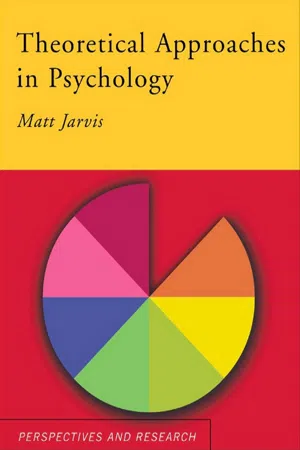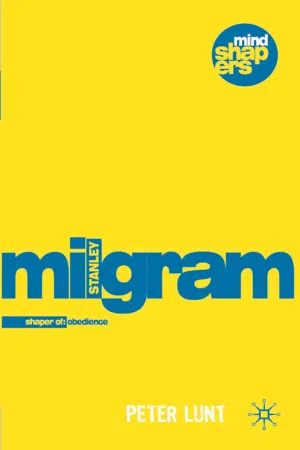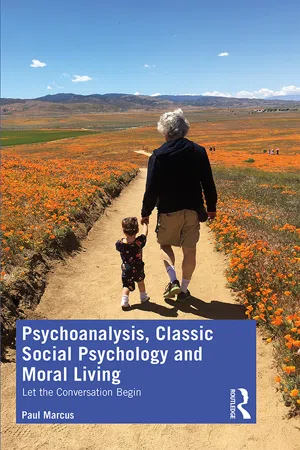Psychology
Milgrams Agency Theory
Milgram's Agency Theory suggests that people may act in ways that are contrary to their personal beliefs or values when they perceive themselves as agents for someone in authority. This theory explains how individuals may relinquish their personal responsibility and moral judgment when following orders from an authority figure, leading to behaviors that they would not typically engage in.
Written by Perlego with AI-assistance
Related key terms
7 Key excerpts on "Milgrams Agency Theory"
- eBook - ePub
- Matt Jarvis(Author)
- 2005(Publication Date)
- Routledge(Publisher)
We are socialised into developing an agentic state during childhood. In school for example, children learn to put aside their individual impulses in favour of maintaining order and so catering for the good of the class as a whole. Milgram proposed that, like children in class, we are all constantly subordinating our own needs and wishes to those of wider society. We can see this tendency in how people act in their jobs. In principle most people would say that they work for their own benefit and would not go out of their way for their employers. In reality, however, once people are in a job and they identify themselves as part of an organisation, they tend to put the needs of the organisation above their own.An important aspect of the agentic state is the way we deal with moral strain. Moral strain results when we have to do something we believe to be morally wrong in order to function as an agent of authority, working for the good of society. Milgram suggested that we use psychological defence mechanisms (including those proposed by Freud—see Chapter 3 ) to get around the distress of having to do morally wrong things. Denial was particularly common in participants in the Milgram studies and in the Holocaust as perpetrators refused to confront what they were doing. It has been widely reported that guards at the Nazi concentration camps were supplied unlimited quantities of alcohol and that they stayed constantly drunk in order to help them deny the horror in which they were participating.Evaluation of agency theory
If we accept that behaviour can be a product of evolution (we will examine this is detail in Chapter 8 - eBook - ePub
Stanley Milgram
Understanding Obedience and its Implications
- Peter Lunt(Author)
- 2009(Publication Date)
- Bloomsbury Academic(Publisher)
Milgram needed three things to work in his experiments to say anything useful about obedience: the situation needed to be a genuine dilemma for the participants, they had to buy into the ‘reality’ of the suffering of the learner and they had to be voluntary collaborators with the authority rather than coerced, fearful victims of blind obedience. Milgram aims to demonstrate that it is possible for a form of obedience that has negative effects to result from a free individual choosing to cooperate with an authority. The surrender of agency to the authority is also critical because, as we will see, it mimics something essential in the democratic process as well as autocratic authority; the public give power to those in authority through consent. Here is the first hint that Milgram was concerned with the conditions under which American citizens were prepared to give their assent to their political leaders as well as the operations of totalitarian regimes.The experimental social psychology tradition of research on social influence informed aspects of Milgram’s design. Asch (1952) had demonstrated that people were prepared to go against their own judgement under social pressure. The study of social influence established the power of pre-commitment. People find it difficult change what they are doing once they have started to behave in a particular way. The study of persuasion demonstrated that people were more susceptible if they were involved in a role-play rather than just hearing arguments (Janis and King, 1954). Janis acted as an advisor on Milgram’s experiments and Asch had employed Milgram as a researcher on one of his projects. Milgram used all these techniques to establish a procedure that would put pressure on his subjects in the context of a moral dilemma that was meaningful to them and in a context in which their actions would apparently lead to severe harm to another human being.Milgram makes a number of important assumptions that shape his approach to explanation. He assumes that psychological processes, as demonstrated in experimental contexts reveal fundamental or essential aspects of human nature. Milgram was frustrated by the way in which social, moral and political theory appeared incapable of resolving key questions about human agency and the tendency of theory to fall into opposing ideological camps. He summed up these oppositions as being between liberals and conservatives that mapped on to different ideas about the right way to organise society and govern people based on accounts of human psychology. He therefore turned to empirical scientific methods to see if he could find answers to some of the classic dilemmas of political theory: are men free or in chains, are human beings agents or subject to political control? How can we account for the Holocaust as a feature of the modern world? Is a ruling elite the best form of democratic government or would greater participation make for a better society? - eBook - ePub
Inaccuracies in Children's Testimony
Memory, Suggestibility, or Obedience to Authority?
- Letitia C Pallone, Jon'A F Meyer(Authors)
- 2013(Publication Date)
- Routledge(Publisher)
Milgram 1974 , p. 132)Milgram later discusses the central concept to his theory of obedience: agentic shift. Agentic shift is defined by Milgram as:an alteration of attitude . . . the person entering an authority system no longer views himself as acting out of his own purposes, but rather comes to see himself as an agent for executing the wishes of another person.(Milgram 1974 , p. 133)The agentic state is not "just another word for obedience . . . it is that state of mental organization which enhances the likelihood of obedience" (Milgram 1974 , p. 148). When an individual feels he or she is in a situation that falls under the control of another person's authority, he or she has entered the agentic state (Milgram 1974 , p. 134). The agentic state, as defined by Milgram, is in direct opposition to the concept of autonomy, or freedom to act as an independent individual. Milgram states that not all persons are destined to enter this agentic state, but "the propensity to do so is exceedingly strong" (Milgram 1974 , p. 134).Milgram's (1974) theory may also generalize to situations far less odious than the task of administering shocks to innocent victims;3 situations such as a child's inaccurate answers during testimony may also be explained, if only in part, by Milgram's theory. For this reason, Milgram's application of his theory to his experiments is presented.Milgram's Application of His Theory to His Experiments
Milgram (1974 - eBook - ePub
Great Ideas in Psychology
A Cultural and Historical Introduction
- Fathali Moghaddam(Author)
- 2013(Publication Date)
- Oneworld Publications(Publisher)
The power of the uniformed authority figure is magnified in the context of institutions, such as the prison. Philip Zimbardo’s simulation of a prison dramatically illustrates this point. Zimbardo randomly assigned healthy young research participants to play the roles of prison guards and prisoners in the context of a simulated prison. The simulation developed in very unexpected directions, both because of the harsh and aggressive behavior of the prison guards and because of the submissive and passive behavior of the prisoners. The context of the prison, and particularly the uniformed guards, overwhelmed the prisoners. This adds to a large body of evidence strongly suggesting a need to safeguard against abuses of power by those in positions of authority, particularly in total institutions.The second important lesson we can learn from psychological research on obedience is the vital role of those who refuse to obey authority figures when obedience will result in harm to others. This disobedient group is sometimes numerically a minority, and it may be no more than a handful in some cases, but it can help prevent disasters. From this perspective, the Milgram experiments are as much about disobedience as they are about obedience. In the United States, about one-third of the participants disobeyed, despite being put under intense pressure by the authority figure, the scientist. In some replications as many as sixty percent of the participants proved to be disobedient.This disobedient group is vitally important, because if the wrong types of individuals manage to get to positions of high authority, then the survival of democracy may depend on individuals who refuse to carry out orders that could be harmful to democracy. Examples from recent US history are those who disobeyed and finally brought down President Richard Nixon during the Watergate scandals of the early 1970s and those who brought an end to the paranoia created by Senator Joseph McCarthy’s anti-communism crusade in the 1950s.There is a third and more subtle lesson to be learned from the Milgram experiments: obedience to authority comes about particularly when the demands to obey are incrementally increased. The participants in Milgram’s studies experienced a gradual, step-by-step increase in demands: they were expected to increase the electric shocks by steps of fifteen volts, starting from an apparently harmless low voltage. Related to this is research on the so-called “foot-in-the-door” phenomenon, demonstrating that people are more likely to comply with a large request if they have earlier complied with a smaller request. Obedience to orders to carry out small acts makes it more likely that individuals will obey orders to carry out more serious actions. This step-by-step process reflects how dictatorships often come into being through incrementally increased demands of obedience. - eBook - ePub
Psychoanalysis, Classic Social Psychology and Moral Living
Let the Conversation Begin
- Paul Marcus(Author)
- 2019(Publication Date)
- Routledge(Publisher)
278). Within a few minutes of entering the laboratory, Milgram’s naïve subjects found themselves being requested—and by prompt number four, ordered—to administer punitive electric shocks to the Learner, what must have felt surreal and overwhelming to their usual sense of themselves as morally feeling and reasoning agents. In such a fast-paced, disorienting, biopsychosocially stressful context, child-like obedience to authority is often the outcome. Disobedience to destructive authority Milgram was very interested in the naïve subjects who were disobedient to the four prods, especially the last one, “You have no choice—you must go on.” 15 Milgram discusses what he calls “strain,” the “experience of tension” in naïve subjects that shows the weakness of the power of authority, in that it only partially transformed the naïve subjects into the agentic state of profound submersion in their roles (1974, pp. 154, 155). Milgram mentions that “residues of selfhood, remaining in varying degrees outside the experimenter’s authority, keep personal values alive in the subject and lead to strain, which, if sufficiently powerful, can result in disobedience” (ibid., p. 155). In other words, it is through personal moral beliefs and values that the disobedient naïve subject maintains his sense of agency, the bedrock of his narrative of self-identity, such that his moral judgments and decisions are lodged in his relatively autonomous inner center of gravity, and not disrupted by the orders of imposing authority and other situational forces that are powerfully bearing down on him - eBook - ePub
- Kenneth S. Bordens, Irwin A. Horowitz(Authors)
- 2013(Publication Date)
- Psychology Press(Publisher)
In short, the individual becomes an agent or instrument of the authority figure. Milgram suggested further that in this agentic state, a person could experience role strain (apprehension about the obedience behavior) that could weaken the agentic state. In an obedience situation, the limits of the role we play are defined for us by the authority source. As long as we are comfortable with, or at least can tolerate, that role, obedience continues. However, if we begin to seriously question the legitimacy of that role, we begin to experience what Mil-gram called role strain. agentic state In the agentic state, an individual becomes focused on the source of authority, tuning in to the instructions issued. role strain The discomfort one feels in an obedience situation that causes a person to question the legitimacy of the authority figure and weakens the agentic state. Humans have a strong predisposition to obey rules and laws. To disobey requires a person to buck existing norms and accept the consequences of disobedience. Rosa Parks defied discriminatory laws in Alabama that required blacks to ride at the back of a bus. She refused setting off a boycott of busses by blacks in Montgomery, Alabama and helping to spark the civil rights movement. In this situation, the individual in the agentic state begins to feel tension, anxiety, and discomfort over his or her role in the obedience situation. In Milgram’s (1974) experiment, participants showed considerable signs of role strain in response to the authority figure’s behavior. As shown in Figure 7.11 on p. 276, very few participants were “not at all tense and nervous.” Most showed moderate or extreme levels of tension and nervousness - eBook - ePub
The Conflicted Mind
And Why Psychology Has Failed to Deal With It
- Geoffrey Beattie(Author)
- 2017(Publication Date)
- Routledge(Publisher)
What Milgram did do instead, some twelve years after completing the obedience experiments, was to present a theory to bind together his empirical observations, a theory which drew upon both evolutionary theory and cybernetics. He hypothesised about the evolutionary advantages of authority-dominated social groups in hostile environments, where individual members can override their individual consciences to act in a more aggressive manner for the leader. Groups cannot act in coordinated ways if everyone follows their own individual conscience and mores. The transition from an autonomous state to a systemic mode of operation requires the individual entering an ‘agentic state’, where responsibility for one's actions is relinquished. Milgram wrote:From a subjective standpoint, a person is in a state of agency when he defines himself in a social situation in a manner that renders him open to regulation by a person of higher status. In this condition the individual no longer views himself as responsible for his own actions but defines himself as an instrument for carrying out the wishes of others.(See Blass 2004: 216)But as Blass and others have noted, this does not explain the variation in level of obedience as a function of experimental condition. After all, they are still being regulated by a person of higher authority in each condition. But there is a much more pressing question. Did Milgram really study hostile environments, where survival is threatened (like on the streets of Belfast in the 1970s) and where we can see the limits of compliance and obedience? Or did he just study individuals in odd conflicting situations that may make some sense for a few minutes and then instinctively stop making any sense? What are the events, and conditions and directives that lead to one outcome rather than another? Milgram after all had written to a government agency in 1960 seeking research funding that ‘Given that a person is confronted with a particular set of commands …. we may ask which conditions increase his compliance, and which make him less likely to comply’. Milgram had found that in his obedience experiments the most effective antidote was the support of others, signalled in his studies through active dissent. On the streets of Belfast, I got some schooling into this. That night by the gates of the church I saw how that might work. But it was all done in the briefest of looks, but looks that have stayed with me. That was what undermined Rob's power. Those fleeting nonverbal signals which told us all that none of us, apart from Rob himself, wanted to go through with this. The active dissent followed on from that. It was conditional on that; it was part of a process. But we know nothing about how these nonverbal signals work in real environments of any significance.
Learn about this page
Index pages curate the most relevant extracts from our library of academic textbooks. They’ve been created using an in-house natural language model (NLM), each adding context and meaning to key research topics.






